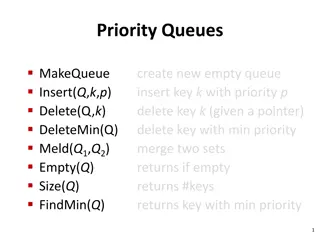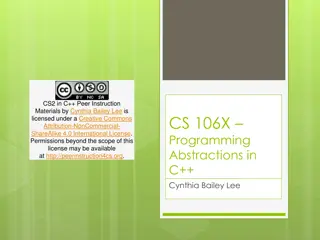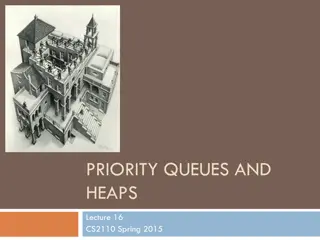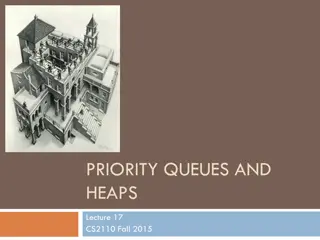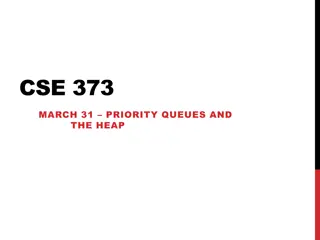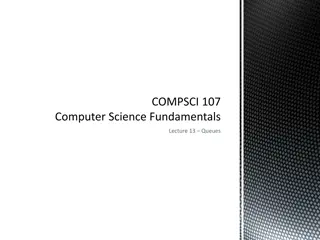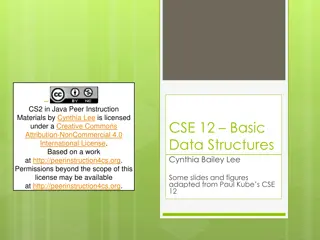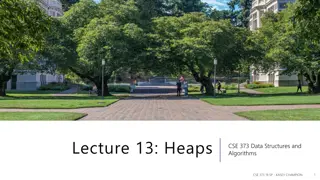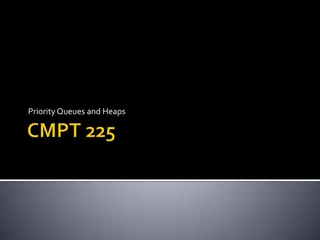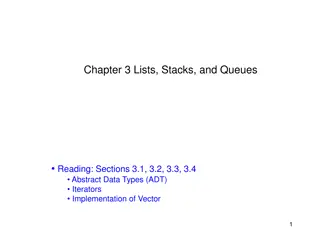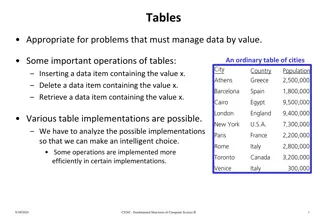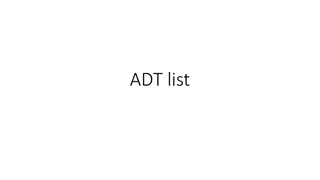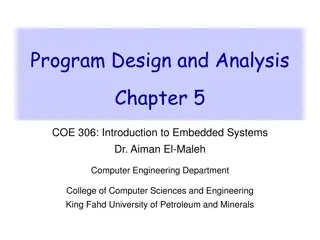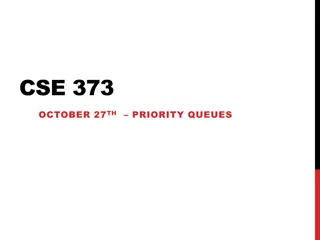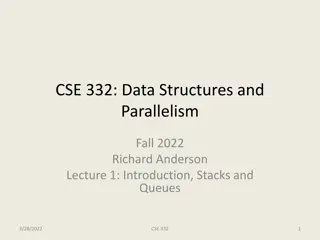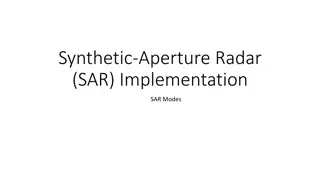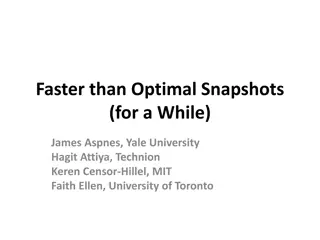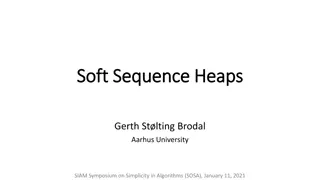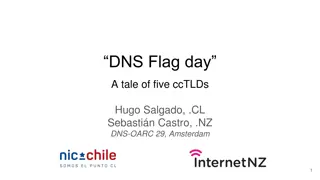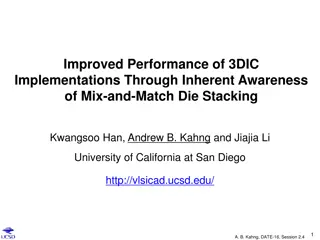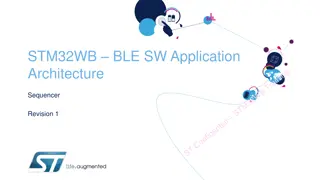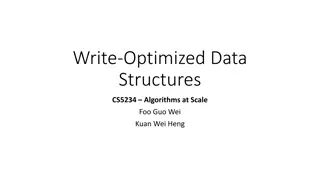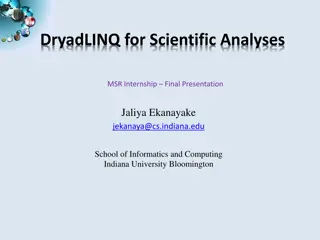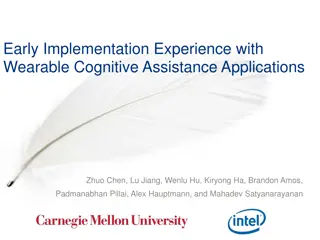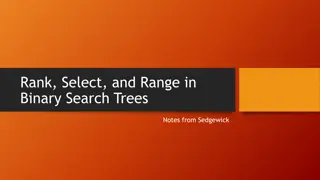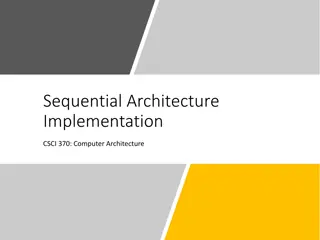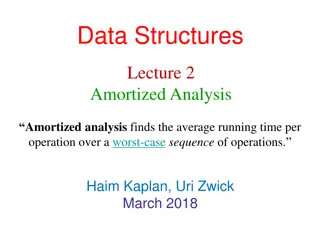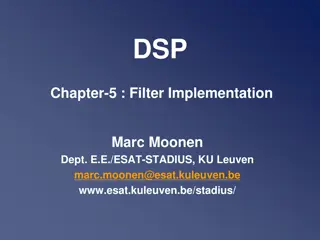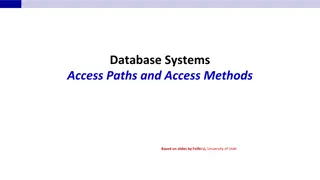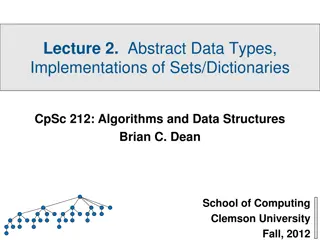Understanding Queues: Operations, Implementations, and Applications
Explore the world of queues, a fundamental data structure with operations like enqueue and dequeue, and implementations using arrays or linked lists. Dive into the applications of queues and their significance in various scenarios. Uncover the basics of queue operations and their practical implications in computer science.
Download Presentation

Please find below an Image/Link to download the presentation.
The content on the website is provided AS IS for your information and personal use only. It may not be sold, licensed, or shared on other websites without obtaining consent from the author. Download presentation by click this link. If you encounter any issues during the download, it is possible that the publisher has removed the file from their server.
E N D
Presentation Transcript
Data Structures Week #4 Queues
Outline Queues Operations on Queues Array Implementation of Queues Linked List Implementation of Queues Queue Applications September 28, 2024 Borahan T mer, Ph.D. 2
Queues (Kuyruklar) A queue is a list of data with the restriction that 1. data can be inserted from the rear or tail, and 2. data can be retrieved from the front or head of the list. By rear we mean a pointer pointing to the element that is last added to the list whereas front points to the first element. A queue is a first-in-first-out(FIFO) structure. September 28, 2024 Borahan T mer, Ph.D. 3
Operations on Queues Two basic operations related to queues: Enqueue (Put data to the rear of the queue) Dequeue (Retrieve data from the front of the queue) September 28, 2024 Borahan T mer, Ph.D. 4
Implementation of Queues Queues can be implemented uing arrays, or LLs September 28, 2024 Borahan T mer, Ph.D. 5
Array Implementation of Queues Queues can be implementedusingarrays. During the execution, queue can grow or shrink within this array. The array has two open ends. One end of the doubly-open-ended array is the rearwhere the insertions are made. The other is the front where elements are removed. September 28, 2024 Borahan T mer, Ph.D. 6
Array Implementation of Queues Initialization: front=0; rear=-1; Condition for an empty queue: In general: rear+1 = front In particular: rear = -1; Condition for a full queue In general: rear-(n-1) = front; In particular: rear n-1; September 28, 2024 Borahan T mer, Ph.D. 7
Sample C Implementation #define queueSize ; struct dataType { } typedef struct dataType dataType; struct queueType { int front; int rear; dataType content[queueSize]; } typedef struct queueType queueType; queueType queue; September 28, 2024 Borahan T mer, Ph.D. 8
Sample C Implementation isEmpty() and isFull() //Initialize Queue (i.e., set value of front and rear to 0) queue.rear=-1; int isEmpty(queueType q) { return (q.rear < q.front); } int isFull(queueType q, int n) { return (q.rear (n-1) >= q.front); } September 28, 2024 Borahan T mer, Ph.D. 9
Enqueue() Operation int enqueue(queueType *qp,int n,dataType item) { if isFull(*qp,n) return 0; //unsuccessful insertion (*qp).content[++(*qp).rear]=item; return 1; //successful insertion } Running time of enqueue O(?) An O(1) operation September 28, 2024 Borahan T mer, Ph.D. 10
Enqueue Operation Animated Empty Queue a enqueued b enqueued c enqueued d enqueued k enqueued l enqueued September 28, 2024 Borahan T mer, Ph.D. 11
Dequeue Operation int dequeue(queueType *qp,dataType *item) { if isEmpty(*qp) return 0; //unsuccessful removal *item = (*qp).content[0]; // always: front = 0 for (i=1; i <= (*qp).rear; i++) (*qp).content[i-1]= (*qp).content[i]; (*qp).rear--; return 1; //successful removal } O(?) An O(n) operation September 28, 2024 Borahan T mer, Ph.D. 12
O(n) Dequeue Operation Animated a dequeued b dequeued c dequeued d dequeued k dequeued l dequeued Empty Queue September 28, 2024 Borahan T mer, Ph.D. 13
Improved Dequeue Operation int dequeue(queueType *qp,dataType *item) { if isEmpty(*qp) return 0; //unsuccessful removal *item = (*qp).content[(*qp).front++]; return 1; //successful removal } An O(1) operation September 28, 2024 Borahan T mer, Ph.D. 14
O(1) Dequeue Operation Animated a dequeued b dequeued c dequeued d dequeued k dequeued l dequeued Empty Queue September 28, 2024 Borahan T mer, Ph.D. 15
Problem of O(1) Dequeue As front proceeds towards the larger indexed elements in the queue, we get supposedly availablebut inaccessible array cells in the queue (i.e., all elements with indices less than that pointed to by front). Whenever rear points to (n-1)st element, a shift operation still needs to be carried out. Solution: attaching the end of the queue to the start!!! Such queues we call circular queues. September 28, 2024 Borahan T mer, Ph.D. 16
Circular Queues Since with the existing conditions an empty and full circular queue is indistinguishable, we redefine the conditions for empty and full queue following a new convention: Convention: front points to the preceding cell of the cell with the data to be removed next. Empty circular queue condition: front=rear Full queue condition: front=(rear+1) mod n September 28, 2024 Borahan T mer, Ph.D. 17
Circular Queues (CQs) //Initialize Queue (i.e., set value of front and rear to n-1) queue.rear=n-1; queue.front=n-1; // i.e., -1 mod n int isEmptyCQ(queueType cq) { return (cq.rear == cq.front); } int isFullCQ(queueType cq, int n) { return (cq.rear == (cq.front-1 % n)); } September 28, 2024 Borahan T mer, Ph.D. 18
Enqueue Operation in CQs int enqueueCQ(queueType *cqp,dataType item) { if isFullCQ(*cqp,n) return 0;//unsuccessful insertion (*cqp).content[++(*cqp).rear % n]=item; return 1; //successful insertion } An O(1) operation September 28, 2024 Borahan T mer, Ph.D. 19
Dequeue Operation in CQs int dequeueCQ(queueType *cqp,dataType *item) { if isEmptyCQ(*cqp) return 0;//unsuccessful removal *item = (*cqp).content[++(*cqp).front % n]; return 1; //successful removal } An O(1) operation September 28, 2024 Borahan T mer, Ph.D. 20
Circular Queues int enqueueCQ(queueType *cqp,dataType item) { if isFullCQ(*cqp) return 0;//unsuccessful insertion (*cqp).content[++(*cqp).rear%n]=item; return 1; //successful insertion } int dequeueCQ(queueType *cqp,dataType *item) { if isEmptyCQ(*cqp) return 0;//unsuccessful removal *item = (*cqp).content[++(*cqp).front%n]; return 1; //successful removal } September 28, 2024 Borahan T mer, Ph.D. 21
Linked List Implementation of Queues //Declaration of a queue node Struct QueueNode { int data; struct QueueNode *next; } typedef struct QueueNode QueueNode; typedef QueueNode * QueueNodePtr; September 28, 2024 Borahan T mer, Ph.D. 22
Linked List Implementation of Queues QueueNodePtr NodePtr, rear, front; NodePtr = malloc(sizeof(QueueNode)); rear = NodePtr; NodePtr->data=2; NodePtr->next=NULL; Enqueue(&rear,&NodePtr); Dequeue( ); // or rear->data=2 // or rear->next=NULL; September 28, 2024 Borahan T mer, Ph.D. 23
Enqueue and Dequeue Functions Void Enqueue (QueueNodePtr *RearPtr, QueueNodePtr *NewNodePtr) { *NewNodePtr = malloc(sizeof(QueueNode)); (*NewNodePtr)->data=5; (*NewNodePtr)->next =NULL; (*RearPtr)->next=*NewNodePtr; *RearPtr = (*RearPtr)->next; } Void Dequeue(QueueNodePtr *FrontPtr) { QueueNodePtr TempPtr; TempPtr= *FrontPtr; *FrontPtr = (*FrontPtr)->next; free(TempPtr); // or you may return TempPtr!!! } September 28, 2024 Borahan T mer, Ph.D. 24
Linked List Implementation of Queues Void Dequeue(QueueNodePtr *FrontPtr) { QueueNodePtr TempPtr; TempPtr= *FrontPtr; *FrontPtr = (*FrontPtr)->next; free(TempPtr); // or return TempPtr!!! } Void Enqueue (QueueNodePtr *RearPtr, QueueNodePtr *NewNodePtr) { *NewNodePtr = malloc(sizeof(QueueNode)); (*NewNodePtr)->data=5; (*NewNodePtr)->next =NULL; (*RearPtr)->next=*NewNodePtr; *RearPtr = (*RearPtr)->next; } September 28, 2024 Borahan T mer, Ph.D. 25
Queue Applications All systems where a queue (a FIFO structure) is applicable can make use of queues. Possible examples from daily life are: Bank desks Market cashiers Pumps in gas stations Examples from computer science are: Printer queues Queue of computer processes that wait for using the microprocessor September 28, 2024 Borahan T mer, Ph.D. 26
Priority Queues While a regular queue functions based on the arrival time as the only criterion as a FIFO structure, this sometimes degrades the overall performance of the system. Consider a printer queue in a multi-processing system where one user has submitted, say, a 200-page-long print job seconds before many users have submitted print jobs of only several pages long. A regular queue would start with the long print job and all others would have to wait. This would cause the average waiting time (AWT) of the queue to increase. AWT is an important measure used to evaluate the performance of the computer system, and the shorter the AWT, the better the performance of the system. September 28, 2024 Borahan T mer, Ph.D. 27
Priority Queues What may be done to improve the performance of the printer queue? Solution: Assign priority values to arriving jobs Then, jobs of the same priority will be ordered by their arrival time. September 28, 2024 Borahan T mer, Ph.D. 28
Priority Queues Assume a printer queue of jobs with three priorities, a, b, and c, where jobs with a (c) have the highest (lowest) priority, respectively. That is, jobs with priority a are to be processed first by their arrival times, and jobs of priority c last. September 28, 2024 Borahan T mer, Ph.D. 29
Priority Queues September 28, 2024 Borahan T mer, Ph.D. 30


